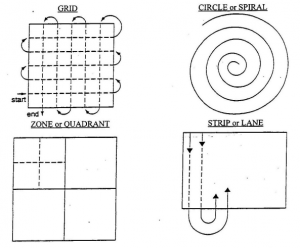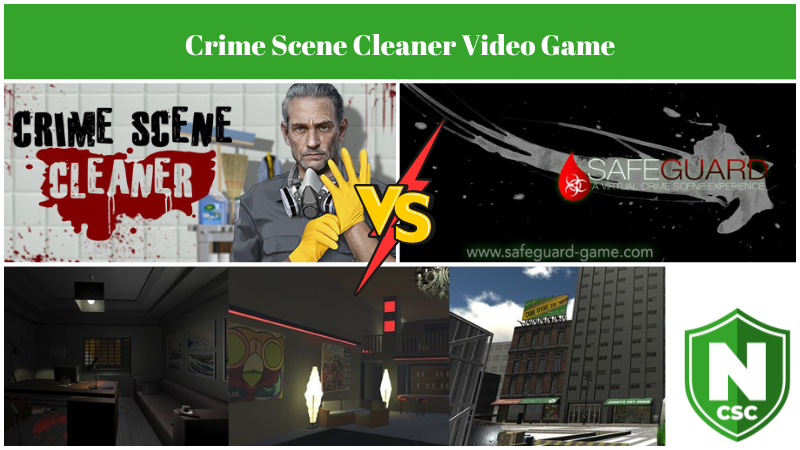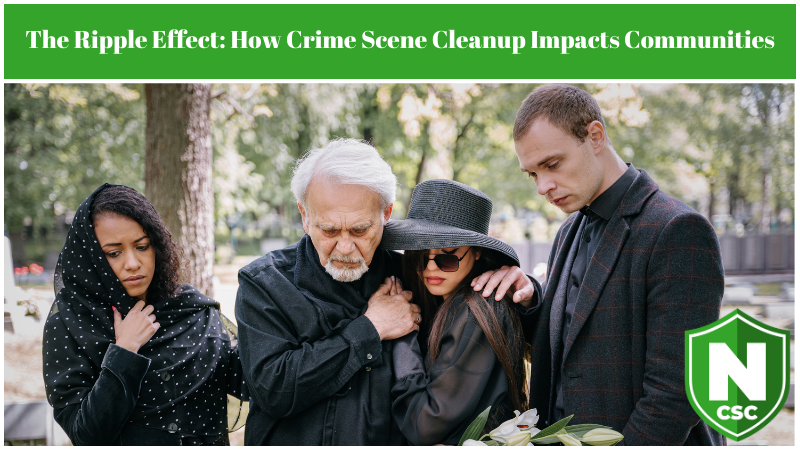Steps in a Crime Scene Investigation
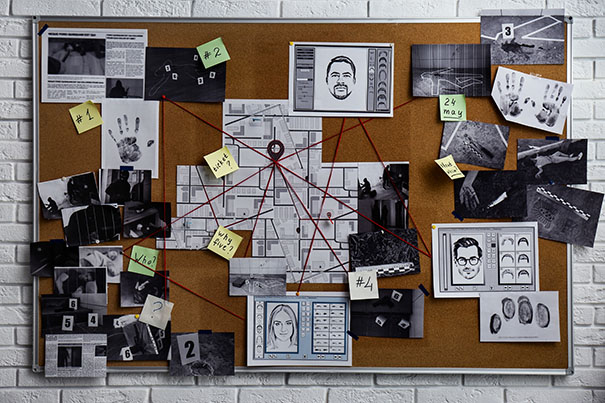
The processing steps in a crime scene investigation is undeniably fascinating. From technology to analysis, the teams that drive crime scene investigations have endless tricks and stories to tell. As cleaners, we have slightly different stories to tell, but we still admire the crews on the scene before us.
Mainstream media makes the process look easy and streamlined–but the reality is that crime scene investigation processing is really not that simple. Film and even social media do an excellent job showing how investigations provoke more questions than answers. As cleaners we know all too well how messy and confusing these crime scenes really are. Still, the difficulty of unraveling an investigation doesn’t excuse certain faults in how some investigations are handled.
Perhaps that’s what makes the entire subject so fascinating. For our purposes, we’ll be breaking down basic informational steps on how forensics reconstruct scenes to uncover the good, the bad, and the ugly.
Step 1: Isolating the Area and Coordinating Teams
Police are generally the first called and first to arrive at a crime scene. Other times it’ll be another specialized crime unit if multiple units are called. The first trained professional should secure and isolate the area by marking a starting and focus point. A starting point might be, for example, the bed where the victim was found murdered. The surrounding area would be isolated with the infamous “do not cross” tape.
Any other area with additional evidence would be isolated upon discovery. This is a far cry from what we do as the cleanup crew. Bio projects and spreads everywhere and contaminates everything, even in areas you’d least expect. (That’s why it’s so important to hire professionals like us for these cleanups!)
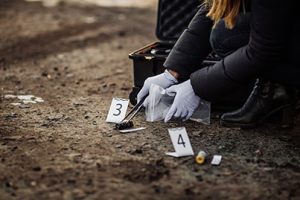
Investigators must use special gloves when collecting evidence.
Step 2: Documenting and Collecting Evidence
Much like the process we take to document the damage and biohazards present in the home, investigators take photos of the blood, the body, stains, and more. The three common methods of documenting a crime scene are:
- Photographs
- Videos
- And notes
Some even sketch the scene–though not all investigators have the same artistic ability. A 3D scanner is sometimes used if the scene is way too confusing or messy.
The scene is searched using one of these four methods:
- Grid (most thorough search method, also most tedious)
- Circle/spiral
- Zone or quadrant
- Strip or lane
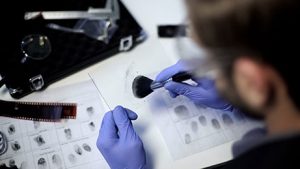
There are several methods used to collect fingerprints. Above a private detective is shown uncovering fingerprint evidence collected by the latent method.
Any officer or specialized crime unit is expected to protect and preserve evidence integral to the case. The common evidence collected:
- Fingerprints and foot tracks
- Clothing with DNA on it (blood, hair, and yes, semen)
- The weapon(s) used
- Residues (e.g. soil or explosives)
- Cell phones, if left at the scene
Once all pertinent evidence is collected, police close the scene and leave the aftermath to the property owner. The property owner or family of the victim then call us to come in and clean the leftover biomatter.
Step 3: The Crime Scene Reconstruction
For complicated, less straightforward crime scenes, forensic scientists actually reconstruct the scene. Perhaps one of the most fascinating steps involved in processing a crime scene–this step is where forensic scientists recreate a mock crime scene. And by mock crime scene, we of course aren’t referring to Halloween.
A mock crime scene in an investigation references a real case. Reconstructions are based on sketches, notes, photos, and evidence from the case. A certified detective is trained to use specialized 3D forensic technology and draw conclusions based on the findings. The crime scenes are reconstructed using:
- Actual props
- 3D Forensic Software
- And Virtual Reality (VR)
Step 4: The Autopsy and Toxicology Reports
A common misconception that we hear is that we remove and transport the body. The coroner or medical examiner is actually the one responsible for identifying the victim, cause of death, and transporting the body. Special training is required to handle the body, especially when an autopsy is required. Depending on the condition of the body and cause of death, an autopsy might not be conducted, but toxicology reports are usually done.
A toxicology report (or a postmortem drug test) is conducted at a lab by forensic toxicologists. A toxicology report essentially confirms the presence of substances, both prescription and illicit, in the body. It can also give general information about the person’s vitals prior to death (e.g. low blood count).
Both are used to determine the circumstances leading up to the crime and the victim’s cause of death. This step can take up to several months, partially because toxicology reports take weeks to develop.
Step 5: Closing a Case
Using the evidence or results from the forensic chemistry report, investigators seek to establish a link between what they have and probable suspect(s). When detectives discover a strong link between a suspect and the evidence, the suspect is charged and the case moves to be closed.
The process might not be this linear. Forensics may backtrack to previous steps to answer new questions as they come along in the investigation, hence the occasional need for a reconstruction. Complications with the case or the investigation can make it challenging to determine clear links. Sometimes the case is later reopened when the wrong suspect is charged. Other times, faults in the investigation can cause delays in arraigning the assailant at the right time.
Factors Preventing Cases from Being Closed
Faults in the investigation or the condition of the body can affect how quickly a case gets resolved. This can cause a case to remain open for months despite damning evidence, an autopsy, and toxicology reports. Sometimes the approach to the investigation is mishandled from the start, which leads to more confusion and delays as evidence is uncovered. With delays comes more opportunities for evidence to be destroyed or for the killer to escape. This leads the case to fall “cold”.
What is a Cold Case and Can They Be Prevented?
What does it mean when a case goes cold? When a suspect isn’t determined after some time, the case risks becoming an open “cold case”.
Can a cold case be prevented? The answer varies depending on the context and case, of course, but more often than not the solution relies on how the investigation is handled initially. This is why it’s more important than ever to have qualified, trained, and dedicated criminal investigators and detectives in the growing field of forensics.
Considering A Career in Crime Scene Investigation?
The field of forensics is constantly growing. If you’ve been inspired to make a difference in others lives or would like to apply your investigative talents in the field, a career in criminal investigation may be for you. Here are a few industry jobs in need of help–along with their projected 10 year market growth:
- Law Enforcement (5%)
- Crime Scene Investigator (14%)
- Private Detective (8%)
- Forensic Chemist (8%)
- Crime Scene Cleaners (8%)
- Forensic Science Technician (14%)


